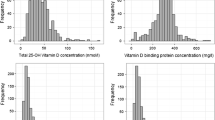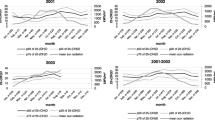Abstract
Studies performed in the Northern Hemisphere and in areas distant from the equator have demonstrated significant seasonal variation in 25-hydroxyvitamin D (25OHD) levels. Whether such variation occurs in a subtropical area such as Australasia is not clear. We performed a cross-sectional study of 1,606 healthy, postmenopausal women recruited over a 33-month period. The study had three goals: to determine the normal levels of 25OHD in healthy postmenopausal women living in Auckland, New Zealand; to determine whether seasonal variation of 25OHD occurs at this latitude; to assess the relationship between 25OHD, biochemical indices, anthropometric variables and bone mineral density (BMD). We found significant seasonal variation in 25OHD levels, with the change in monthly ultraviolet dose from summer to winter being followed 6–8 weeks later by a corresponding change in 25OHD levels. Vitamin D insufficiency (25OHD <50 nmol/l) was common. During summer, 28–58% of participants had suboptimal vitamin D status, while in winter, the frequency increased to 56–74%. 25OHD levels correlated with participants’ age (r=−0.15), weight (r=−0.11), body mass index (r=−0.13), fat mass (r=−0.14), percentage body fat (r=−0.16), physical activity (r=0.10) and the month of blood sampling (all P<0.0001). Collectively, age, fat mass, physical activity, and month of sampling explained 21% of the variance in 25OHD. No significant relationships were noted between 25OHD and BMD at any site. Other variables that showed significant monthly variation were glucose (P=0.002), serum phosphate, alkaline phosphatase, and albumin (all P<0.0001). There was no monthly variation in BMD at the lumbar spine or proximal femur. In conclusion, there is significant seasonal variation in 25OHD levels, even in a subtropical climate. Furthermore, despite generous amounts of sunlight, considerable numbers of women have suboptimal vitamin D status, even in summer. Our findings support the suggestion that vitamin D supplementation should become standard practice in this population of women, particularly during winter.


Similar content being viewed by others
References
Dawson-Hughes B, Dallal GE, Krall EA, Harris S, Sokoll LJ, Falconer G (1991) Effect of vitamin D supplementation on wintertime and overall bone loss in healthy postmenopausal women. Ann Intern Med 115:505–512
Ooms ME, Roos JC, Bezemer PD, van der Vijgh WJ, Bouter LM, Lips P (1995) Prevention of bone loss by vitamin D supplementation in elderly women: a randomized double-blind trial. J Clin Endocrinol Metab 80:1052–1058
Lips P, Duong T, Oleksik A, Black D, Cummings S, Cox D, Nickelsen T (2001) A global study of vitamin D status and parathyroid function in postmenopausal women with osteoporosis: baseline data from the multiple outcomes of raloxifene evaluation clinical trial. J Clin Endocrinol Metab 86:1212–1221
Dawson-Hughes B, Harris SS, Krall EA, Dallal GE (1997) Effect of calcium and vitamin D supplementation on bone density in men and women 65 years of age or older. N Engl J Med 337:670–676
Chapuy MC, Arlot ME, Duboeuf F, Brun J, Crouzet B, Arnaud S, Delmas PD, Meunier PJ (1992) Vitamin D3 and calcium to prevent hip fractures in the elderly women. N Engl J Med 327:1637–1642
Nowson CA, Margerison C (2002) Vitamin D intake and vitamin D status of Australians. Med J Aust 177:149–152
Hill T, Collins A, O’Brien M, Kiely M, Flynn A, Cashman KD (2004) Vitamin D intake and status in Irish postmenopausal women. Eur J Clin Nutr 59:404–410
Lips P (2001) Vitamin D deficiency and secondary hyperparathyroidism in the elderly: consequences for bone loss and fractures and therapeutic implications. Endocr Rev 22:477–501
Woitge HW, Scheidt-Nave C, Kissling C, Leidig-Bruckner G, Meyer K, Grauer A, Scharla SH, Ziegler R, Seibel MJ (1998) Seasonal variation of biochemical indexes of bone turnover: results of a population-based study. J Clin Endocrinol Metab 83:68–75
Rapuri PB, Kinyamu HK, Gallagher JC, Haynatzka V (2002) Seasonal changes in calciotropic hormones, bone markers, and bone mineral density in elderly women. J Clin Endocrinol Metab 87:2024–2032
Woitge HW, Knothe A, Witte K, Schmidt-Gayk H, Ziegler R, Lemmer B, Seibel MJ (2000) Circaannual rhythms and interactions of vitamin D metabolites, parathyroid hormone, and biochemical markers of skeletal homeostasis: a prospective study. J Bone Miner Res 15:2443–2450
Wilson PW, Paffenbarger RS Jr, Morris JN, Havlik RJ (1986) Assessment methods for physical activity and physical fitness in population studies: report of a NHLBI workshop. Am Heart J 111:1177–1192
Carter GD, Carter CR, Gunter E, Jones J, Jones G, Makin HL, Sufi S (2004) Measurement of vitamin D metabolites: an international perspective on methodology and clinical interpretation. J Steroid Biochem Mol Biol 89–90:467–471
WHO scientific group on the prevention and management of osteoporosis (2003) Prevention and management of osteoporosis: report of a WHO scientific group. World Health Organisation, Geneva
Pasco JA, Henry MJ, Nicholson GC, Sanders KM, Kotowicz MA (2001) Vitamin D status of women in the Geelong Osteoporosis Study: association with diet and casual exposure to sunlight. Med J Aust 175:401–405
McGrath JJ, Kimlin MG, Saha S, Eyles DW, Parisi AV (2001) Vitamin D insufficiency in south-east Queensland. Med J Aust 174:150–151
McAuley KA, Jones S, Lewis-Barned NJ, Manning P, Goulding A (1997) Low vitamin D status is common among elderly Dunedin women. N Z Med J 110:275–277
McKenzie RL, Bodeker GE, Keep DJ, Kotkamp M (1996) UV radiation in New Zealand: north-to-south differences between two sites, and relationship to other latitudes. Weather Climate 16:17–26
Tangpricha V, Pearce EN, Chen TC, Holick MF (2002) Vitamin D insufficiency among free-living healthy young adults. Am J Med 112:659–662
Pasco JA, Henry MJ, Kotowicz MA, Sanders KM, Seeman E, Pasco JR, Schneider HG, Nicholson GC (2004) Seasonal periodicity of serum vitamin D and parathyroid hormone, bone resorption, and fractures: the Geelong Osteoporosis Study. J Bone Miner Res 19:752–758
Hine TJ, Roberts NB (1994) Seasonal variation in serum 25-hydroxy vitamin D3 does not affect 1,25-dihydroxy vitamin D. Ann Clin Biochem 31:31–34
Haddad JG, Jr., Rojanasathit S (1976) Acute administration of 25-hydroxycholecalciferol in man. J Clin Endocrinol Metab 42:284–290
Holick MF, Matsuoka LY, Wortsman J (1989) Age, vitamin D, and solar ultraviolet. Lancet 2:1104–1105
Nordin BE, Need AG, Morris HA, O’Loughlin PD, Horowitz M (2004) Effect of age on calcium absorption in postmenopausal women. Am J Clin Nutr 80:998–1002
Clements MR, Johnson L, Fraser DR (1987) A new mechanism for induced vitamin D deficiency in calcium deprivation. Nature 325:62–65
Chel VG, Ooms ME, Popp-Snijders C, Pavel S, Schothorst AA, Meulemans CC, Lips P (1998) Ultraviolet irradiation corrects vitamin D deficiency and suppresses secondary hyperparathyroidism in the elderly. J Bone Miner Res 13:1238–1242
Need AG, Morris HA, Horowitz M, Nordin C (1993) Effects of skin thickness, age, body fat, and sunlight on serum 25-hydroxyvitamin D. Am J Clin Nutr 58:882–885
Arunabh S, Pollack S, Yeh J, Aloia JF (2003) Body fat content and 25-hydroxyvitamin D levels in healthy women. J Clin Endocrinol Metab 88:157–161
Jacques PF, Felson DT, Tucker KL, Mahnken B, Wilson PW, Rosenberg IH, Rush D (1997) Plasma 25-hydroxyvitamin D and its determinants in an elderly population sample. Am J Clin Nutr 66:929–936
Wortsman J, Matsuoka LY, Chen TC, Lu Z, Holick MF (2000) Decreased bioavailability of vitamin D in obesity. Am J Clin Nutr 72:690–693
Holick MF (1995) Environmental factors that influence the cutaneous production of vitamin D. Am J Clin Nutr 61:638S–645S
Gloth FM 3rd, Gundberg CM, Hollis BW, Haddad JG Jr, Tobin JD (1995) Vitamin D deficiency in homebound elderly persons. JAMA 274:1683–1686
Sigurdsson G, Franzson L, Steingrimsdottir L, Sigvaldason H (2000) The association between parathyroid hormone, vitamin D and bone mineral density in 70-year-old Icelandic women. Osteoporos Int 11:1031–1035
Kudlacek S, Schneider B, Peterlik M, Leb G, Klaushofer K, Weber K, Woloszczuk W, Willvonseder R (2003) Assessment of vitamin D and calcium status in healthy adult Austrians. Eur J Clin Invest 33:323–331
Sherman SS, Tobin JD, Hollis BW, Gundberg CM, Roy TA, Plato CC (1992) Biochemical parameters associated with low bone density in healthy men and women. J Bone Miner Res 7:1123–1130
Overgaard K, Nilas L, Johansen JS, Christiansen C (1988) Lack of seasonal variation in bone mass and biochemical estimates of bone turnover. Bone 9:285–288
Rosen CJ, Morrison A, Zhou H, Storm D, Hunter SJ, Musgrave K, Chen T, Wei W, Holick MF (1994) Elderly women in northern New England exhibit seasonal changes in bone mineral density and calciotropic hormones. Bone Miner 25:83–92
Robertson WG, Gallagher JC, Marshall DH, Peacock M, Nordin BE (1974) Seasonal variations in urinary excretion of calcium. Br Med J 4:436–437
Sahota O, Masud T, San P, Hosking DJ (1999) Vitamin D insufficiency increases bone turnover markers and enhances bone loss at the hip in patients with established vertebral osteoporosis. Clin Endocrinol (Oxf) 51:217–221
Storm D, Eslin R, Porter ES, Musgrave K, Vereault D, Patton C, Kessenich C, Mohan S, Chen T, Holick MF, Rosen CJ (1998) Calcium supplementation prevents seasonal bone loss and changes in biochemical markers of bone turnover in elderly New England women: a randomized placebo-controlled trial. J Clin Endocrinol Metab 83:3817–3825
Melin A, Wilske J, Ringertz H, Saaf M (2001) Seasonal variations in serum levels of 25-hydroxyvitamin D and parathyroid hormone but no detectable change in femoral neck bone density in an older population with regular outdoor exposure. J Am Geriatr Soc 49:1190–1196
Jacobsen SJ, Goldberg J, Miles TP, Brody JA, Stiers W, Rimm AA (1991) Seasonal variation in the incidence of hip fracture among white persons aged 65 years and older in the United States, 1984–1987. Am J Epidemiol 133:996–1004
Chiu KY, Ng TP, Chow SP (1996) Seasonal variation of fractures of the hip in elderly persons. Injury 27:333–336
Bulajic-Kopjar M (2000) Seasonal variations in incidence of fractures among elderly people. Inj Prev 6:16–19
Thompson PW, Taylor J, Dawson A (2004) The annual incidence and seasonal variation of fractures of the distal radius in men and women over 25 years in Dorset, UK. Injury 35:462–466
Douglas S, Bunyan A, Chiu KH, Twaddle B, Maffulli N (2000) Seasonal variation of hip fracture at three latitudes. Injury 31:11–19
Letellier G, Desjarlais F (1982) Study of seasonal variations for 18 biochemical parameters over a 4-year period. Clin Biochem 15:206–211
Ljunghall S, Hedstrand H, Hellsing K, Wibell L (1977) Calcium, phosphate and albumin in serum. A population study with special reference to renal stone formers and the prevalence of hyperparathyroidism in middle-aged men. Acta Med Scand 201:23–30
Behall KM, Scholfield DJ, Hallfrisch JG, Kelsay JL, Reiser S (1984) Seasonal variation in plasma glucose and hormone levels in adult men and women. Am J Clin Nutr 40:1352–1356
Suarez L, Barrett-Connor E (1982) Seasonal variation in fasting plasma glucose levels in man. Diabetologia 22:250–253
Scragg R, Holdaway I, Singh V, Metcalf P, Baker J, Dryson E (1995) Serum 25-hydroxyvitamin D3 levels decreased in impaired glucose tolerance and diabetes mellitus. Diabetes Res Clin Pract 27:181–188
Boucher BJ (1998) Inadequate vitamin D status: does it contribute to the disorders comprising syndrome ‘X’? Br J Nutr 79:315–327
Binkley N, Krueger D, Cowgill CS, Plum L, Lake E, Hansen KE, DeLuca HF, Drezner MK (2004) Assay variation confounds the diagnosis of hypovitaminosis D: a call for standardization. J Clin Endocrinol Metab 89:3152–3157
Carter GD, Carter R, Jones J, Berry J (2004) How accurate are assays for 25-hydroxyvitamin D? Data from the international vitamin D external quality assessment scheme. Clin Chem 50:2195–2197
Hollis BW (2004) Editorial: The determination of circulating 25-hydroxyvitamin D: no easy task. J Clin Endocrinol Metab 89:3149–3151
Acknowledgements
We wish to thank Dr. Richard McKenzie for supplying the UV data. This trial was funded by the Health Research Council of New Zealand. MB is the recipient of an Australian and New Zealand Bone and Mineral Society (ANZBMS) Postgraduate Research Scholarship.
Author information
Authors and Affiliations
Corresponding author
Additional information
Jenny A. Lucas and Mark J. Bolland contributed equally to this work.
Rights and permissions
About this article
Cite this article
Lucas, J.A., Bolland, M.J., Grey, A.B. et al. Determinants of vitamin D status in older women living in a subtropical climate. Osteoporos Int 16, 1641–1648 (2005). https://doi.org/10.1007/s00198-005-1888-2
Received:
Accepted:
Published:
Issue Date:
DOI: https://doi.org/10.1007/s00198-005-1888-2




